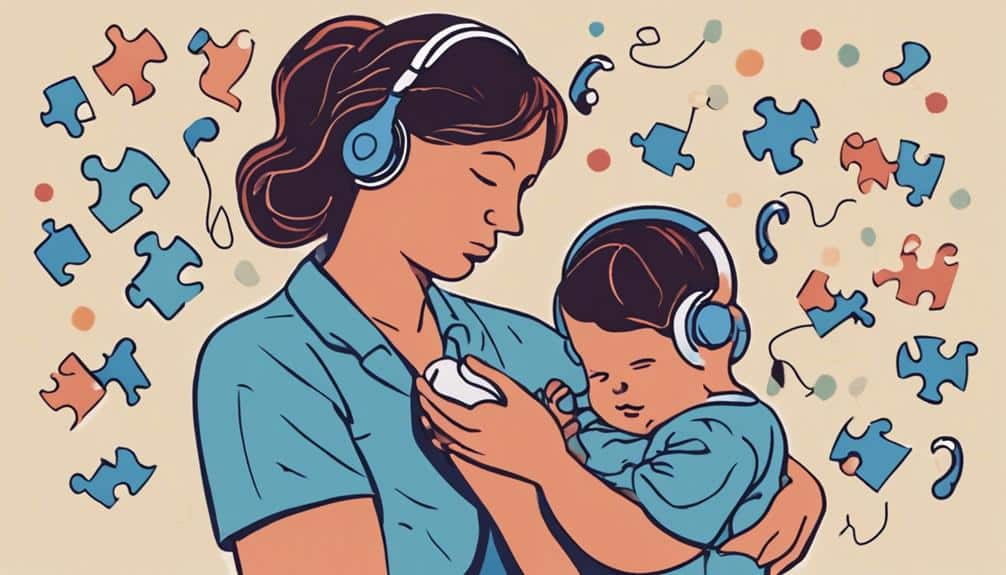Key Takeaways
- Recognize early warning signs such as delayed speech, limited communication skills, and unusual fixations or repetitive behaviors.
- Understand the importance of early intervention in enhancing social interaction and promoting independence.
- As parents, educate yourself about autism and create a supportive environment for your child to encourage positive interactions.
- Collaborate with healthcare providers and specialists to monitor progress and adjust necessary interventions.
- Regularly monitor your child’s developmental milestones and seek professional evaluation when you notice sensory sensitivities.
Recognizing Social Skills Deficits
In autism, one of the biggest challenges these children face is recognizing and interpreting social cues, body language, and facial expressions. This difficulty often results in social interaction deficits, manifesting as challenges initiating and maintaining conversations. DIR/Floortime strategies can be particularly effective in addressing these challenges by fostering the development of non-verbal cues, emotion regulation, and reciprocal interactions. These warning signs of autism can significantly affect autistic communication abilities.
Children on the autism spectrum may seem uninterested in others or experience difficulties understanding emotions. This lack of social skills can hinder their ability to form meaningful relationships. Yet, it’s essential to understand these challenges are not indicative of a lack of desire for social interaction but rather a struggle to comprehend and respond to social cues.
Early intervention is essential for children with Autism Spectrum Disorder (ASD). Recognizing these signs early can lead to interventions that improve social communication skills, enhancing their interactions with others. Understanding the impact of these social skills deficits is crucial in providing appropriate support for children with autism. This awareness allows caregivers and professionals to address these deficits, ultimately leading to improved relationships and communication for children on the autism spectrum.
Understanding Communication Challenges
Children with autism often encounter significant communication challenges impacting their daily lives. These challenges can be verbal or nonverbal. Many children with autism may struggle with making eye contact, responding to their names, or initiating conversations. These critical communication aspects allow us to connect and establish relationships with others.
Moreover, these challenges mean that autistic children often exhibit delayed speech and language skills, which can hinder their ability to engage in meaningful conversations. Additionally, a significant number of children with autism have limited or no verbal communication skills. This limitation often makes it difficult for them to express their needs and feelings, resulting in frustration for the child and those around them. Nonverbal communication, such as understanding gestures and body language, may also pose a significant challenge.
One specific area of communication that children with autism often have trouble with is emotional understanding. Recognizing emotions in others and utilizing their feelings can be difficult, further complicating their ability to communicate effectively. However, by identifying these communication challenges early and considering the importance of early intervention, parents can help their autistic children develop better communication skills and improve their social interactions.
Identifying Behavioral Issues

Behavioral challenges form an integral part of understanding the complex nature of Autismism. Children on the spectrum often exhibit certain behaviors that deviate from the norm, necessitating an early diagnosis for better management and support. This is where family-centered autism therapy can play an instrumental role, providing a collaborative and personalized approach to manage these behaviors and support the child’s comprehensive development.
Repetitive behaviors, such as hand-flapping, spinning objects, or repeating phrases, can signal the presence of Autismism in a child. These repetitive actions often serve as a coping mechanism for children with autism, helping them understand their surroundings. As part of a holistic approach, understanding these behaviors can create tailored plans that address the child’s distinct needs.
Unusual interests or fixations on specific topics can also be observed. A child might become engrossed in a single topic, such as a type of animal or a cartoon character, demonstrating an intensity that goes beyond typical curiosity.
Resistance to change is another critical behavioral issue. Children with autism can find changes or disruptions in routines distressing. They often adhere to strict rules or routines and become stressed when disrupted.
Addressing these behavioral challenges early can significantly improve the child’s life. Early diagnosis and intervention are vital in managing autism, aiding child development, and supporting overall well-being.
Other Autism Signs and Considerations
Beyond behavioral issues, some otheAutisms and considerations can indicate a child may have Autism. Sensitivity to sounds, gastrointestinal problems, and uncommon behaviors such as toe walking could indicate spectrum disorders and are potential indicators of autism that parents should be aware of.
Incorporating a collaborative family focus is critical to understanding and addressing these signs. The involvement of primary figure autism parents and caregivers can extend therapy benefits, reinforce professional interventions, and facilitate a smooth shift of skills.
Early detection is vital for the child’s development. Therefore, it is essential to recognize that these signs do not indicate a child’s quirkiness or uniqueness but could signal that a child might have autism. Understanding these additional signs is beneficial not only for parents but also for those who interact with the child regularly.
The “Guide to the Initial Signs of Autism” serves as a complete parent guide to Autismism, shedding light on the broader spectrum of signs and symptoms associated with this condition. Recognizing these signs can prompt parents to seek early medical evaluation for their child with autism.
Importance of Early Intervention.

Building on understanding additional cues and considerations linked to autism, Autismow focuses on the vital role that prompts autism. Autism research indicates that Autism Spectrum Disorder (ASD) can be identified as early as age two, underscoring the importance of early detection. This early recognition of ASD can have a significant impact on a child’s development, offering the child enhanced opportunities for growth and learning. Early intervention strategies can enhance communication skills, social interaction, and overall skill advancement.
Identifying the early warning signs of Autism is the initial crucial step towards getting your child the assistance they require. Once these early indicators are recognized in children, it allows swift access to support services, and timely intervention is fundamental for improving their developmental outcomes.
Early intervention has numerous advantages. It can assist children with ASD in enhancing their social, communication, and adaptive skills. It equips them with tools and tactics to navigate the challenges posed by their condition. Moreover, it provides parents with the knowledge and resources to create a supportive environment for their children.
Frequently Asked Questions
What are the Early Warning Signs of Autism I should watch for in my baby?
Look for signs like avoiding eye contact, not responding to their name, or delayed speech development. Other signs include repetitive behaviors, like hand-flapping, and unusual reactions to sounds or textures.
How Do You Detect Autism in Early Stages?
Early autism detection involves observing key developmental markers. Signs include limited eye contact, delayed speech, repetitive behaviors, lack of social smiling, and response to name. Sensory sensitivities and atypical behaviors also warrant professional consultation.
What Are the Red Flags Used in Early Diagnosis of Autism?
Red flags for early autism diagnosis include delayed speech, limited social interaction, repetitive behaviors, sensitivity to sensory stimuli, uncommon object attachments, and intense fixation on specific topics. Early detection facilitates improved developmental outcomes.
If I notice the Early Warning Signs of Autism, what should I do next?
Consult with your pediatrician as soon as possible for an evaluation and guidance. Early intervention can help support your child’s development and give them the best opportunities to thrive.
What Is One of the Earliest Indicators of an Autism Spectrum Disorder?
One of the earliest indicators of an autism spectrum disorder can be a lack of typical babbling or cooing by 12 months old, suggesting potential communication difficulties, a critical characteristic of Autism.
Is the Biggest Symptom of Autism?
The predominant symptom of autism is persistent deficits in social communication and interaction. These may manifest as difficulties in understanding social cues, eye contact, and emotions, alongside communication challenges and repetitive behavior.
Conclusion
In this exploration domain, one can perceive the immense significance of early recognition of autism issues, which is a key to revealing potential. Understanding these indicators enables proactive measures, amplifying the effectiveness of interventions and support. The impact on a child’s developmental autism’s futures and transforms lives. This guide illuminates the path toward comprehension, a guidepost for parents maneuvering through the intricacies of Autism. Let it be the catalyst for nurturing a brighter, more inclusive tomorrow.


Recent Comments